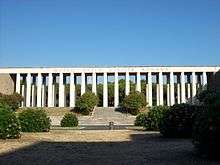Museum of Roman Civilization
| Museo della Civiltà Romana | |
 | |
 Location within Rome | |
| Established | 1952 |
|---|---|
| Location | Piazza Giovanni Agnelli 10, 00144 Rome, Italy |
| Type | archaeology, Art museum |
| Website |
www |

The Museum of the Roman Civilization (Italian "Museo della Civiltà Romana") is a museum in Rome (Esposizione Universale Roma district), devoted to the aspects of the Ancient Roman civilization.
History and General Introduction
It was designed by the architects Pietro Ascheri, D. Bernardini and Cesare Pascoletti[1] (1939-1941). Its 59 sections illustrate the history of Roman civilization, from the origins to the 4th century, with models and reproductions, as well as original material. The premises are shared with a planetarium.
It houses, among other things:
- a model of Archaic Rome (Room XVIII)
- a famous scale model of ancient Rome in the age of Constantine I by Italo Gismondi (Room XXXVII-XXXVIII): derived from the Forma Urbis Romae map and integrated with archeological discoveries. This model is at a 1:250 scale and is made of plaster. The model was begun in 1935 and completed in 1971. This model is today the most important reference for any serious attempt of reconstruction of the Ancient Rome: it has been used for the "Rome Reborn 1.0" 3D Visualization Project (B. Frischer, Director, University of Virginia; D. Favro, Associate Director, UCLA; D. Abernathy, Director of 3D Modeling, University of Virginia; G. Guidi, Director of 3D Scanning, Politecnico di Milano). Gismondi's model can be seen also in a few shots of the Movie "Gladiator" by R. Scott.
- examples of late imperial and early Christian art
- a complete sequence of casts of the spiral reliefs round Trajan's Column, arranged in horizontal rows at ground level to facilitate reading.
- a reconstructed Roman library based on that in the Villa Adriana at Tivoli
Structure of the Museum
There are three main different itineraries through the Rooms of the Museum:
- The Historical sections
- The Thematic sections
- The Model of the Imperial Rome
The Historical Sections
- Room V-VI: Roman legends and primitive culture - the origins of Rome
- Room VII: The conquest of the Mediterranean
- Room VIII: Caesar
- Room IX: Augustus
- Room X: Augustus’ family and the Julio-Claudian emperors
- Room XI: The Flavians
- Room XII: Trajan and Hadrian
- Room XIII: The emperors from Antonius Pius to the Severans
- Room XIV: The emperors from Macrinus to Justinian
- Room XV: Christianity
- Room XVI: The army
- Room XVIII: Model of archaic Rome
The Thematic Sections
- Room XXXVI: School
- Room XXXIX: Living spaces
- Room XLVI: Rights
- Room XLVII: Libraries
- Room XLVIII: Music
- Room XLIX: Literature and science
- Room L: Medicine and drugs
- Room LI: Trajan’s Column
- Room LII: Industry and craft
- Room LIII: Agriculture, herding and land management
- Room LIV: Hunting, fishing and food
- Room LV: Commerce and economic life
- Room LVI: Art of rome
The Model of Imperial Rome
- Room XXXVII-XXXVIII: Model of Imperial Rome (in the age of Constantine I)
Appearance in popular culture
In the James Bond film Spectre, the marble colonnade of the museum doubled as a cemetery after the Archconfraternity of the Departed [2] confraternity barred the filming of a funeral scene at the Campo Verano cemetery.[3][4]
References
- ↑ The Buildings of Europe: Rome, section 191, Christopher Woodward, Manchester University Press, Manchester, 1995, ISBN 0-7190-4032-9
- ↑ Arciconfraternita di Carità verso i Trapassati
- ↑ "James Bond: New 'Spectre' Pic Starts Rome Segment Shoot". Variety. Retrieved 5 June 2016.
- ↑ "James Bond ordered not to film in Roman cemetery". The Guardian. Retrieved 5 June 2016.
External links
| Wikimedia Commons has media related to Museo della civiltà romana (Rome). |
Coordinates: 41°49′55″N 12°28′41″E / 41.83194°N 12.47806°E